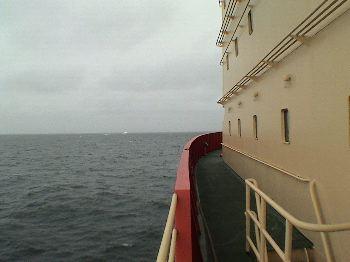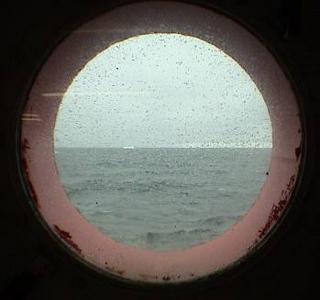6 February, 2004
When we are doing seismic the changing of the guard marks our time on
watch. Our shift moves quickly on the seismic days, rotating between
data logging, Marine Mammal Observation and ping editing. But today
things are different. We have left the quite of McMurdo Sound and
are now in the open water of the Ross Sea. Icebergs and sea ice are
little more than a nuisance to the pilots, as we occasionally have to
change course to avoid a rogue berg.
The sky and sea have melted together into a wash of gray. The sun is
hidden behind the clouds and fog. It is difficult to determine which
way the ship is moving, because the sun gives us no hints, hidden
behind a blanket of fog and clouds. The mood of the ship matches the
weather. People seem to be resolved to making it through their
shift, and then heading to a quite place where they can read or be
alone. Mealtime lacks the usual banter. Food is eaten, eyes
forward, then back to work. We have grown so accustomed to bright
skies that this is a shock to our system.
The seas have become a little choppier, but not enough to send anyone
to bed from seasickness. It is a little more difficult doing the
Marine Mammal Observing, as we try and distinguish the small spray of
a breaking wave from the blow from a surfacing whale. We have seen
only birds since we headed north, mostly seabirds that fly close to
the water looking for a quick meal.
On the seismic front, the scientists have been locating features in
the data that they have identified as possibly being dikes. A dike
is feature in the crust that is large region of igneous rock that has
intruded into the layers of rocks that make up the existing crust in
that area. Dykes are interesting features because they are the
result of forces that are out of the "norm" that formed the rocks in
a parcticular area. The scientists will look at the data from
multiple shot lines to try and determine the direction, relative
length and thickness of these features.
Launching the sonobuoys has become a problem. With the increase in
the winds and the larger waves, the buoys are quickly blown back into
the streamer where they get tangled and stop working. The marine
techs have begun to launch them from a tube using compressed air to
get them further from the ship.
There seems to be a poltergeist in the electronics systems. For most
of the day the computer and electronics techs have been trying to
track down minor annoyances in the system. They have had to deal
with everything from the seismic printers making rows of lines across
the top of the chart for no apparent reason, to the multibeam
freezing up for with no warning. Everyone did an outstanding job
trying to identify the source of the problems, but for the most part,
the pace of the work allowed only enough time to get things up and
running again with a note to check things out further when time
allowed.
The change in weather has put a somber mood over the whole ship. As
soon as the shift ended, people scurried to their rooms. It was time
to catch up on sleep. The motion of the waves took its toll
throughout the day. It is much harder to stay focused, and the
constant rocking keeps you slightly on edge. Knowing that you don't
have to be on duty is a relief; as you lay in your bunk, the waves
gently rock you to sleep. The waves constantly confound our systems.
When we are awake the waves force us to struggle to find our bearing.
When we sleep the waves caress us into never land as though we didn't
have a care.

The sea and the cloudy sky blend together on the horizon.

No one is out on deck. Our view is limited to the portholes.

Contact the TEA in the field at
.
If you cannot connect through your browser, copy the
TEA's e-mail address in the "To:" line of
your favorite e-mail package.
|
